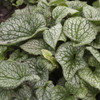Product Description
Brunnera m. 'Queen of Hearts' PP32737 (4) 1-gallons
Common Name: Heartleaf Brunnera, Siberian Bugloss
This stunning foliage perennial will be the queen of the shade (and your heart). Compared to its companion plant 'Jack of Diamonds', 'Queen of Hearts' has more heart-shaped leaves and more pronounced silver overlay with narrower bands of dark green veining. From mid to late spring, baby blue, forget-me-not type blossoms are held in clusters above the foliage.
Height: 16.0-18.0 Inches
Spread: 28.0-36.0 Inches
Scape Height: 30.0 Inches
Hardiness Zones: 3,4,5,6,7,8
Flower Color: Blue shades
Foliage Color: Silver/grey shades
Part Shade (4-6 hrs. Direct Sun) to Full Shade (< 4 hrs. Direct Sun)
Average to Consistent Water Needs
Average to Fertile Soil Quality
Bloomtime: Mid Spring - Late Spring
Bee Friendly
Deer Resistant
Growth Rate: Medium
Border Plant, Container, Cut Flower, Cut Foliage, Mass Planting, Specimen, Focal Point
Brunnera macrophylla 'Queen of Hearts' is a stunning perennial that is highly valued for its large, heart-shaped leaves and delicate blue flowers. It is a fantastic addition to shade gardens, adding a touch of elegance and brightness to areas where other plants might struggle. Here is a closer look at what makes it special:
Appearance:
- Foliage: 'Queen of Hearts' is primarily grown for its striking foliage. The large, heart-shaped leaves are a beautiful silver color with a network of dark green veins. The leaves can reach up to 9-10 inches across, creating a bold and eye-catching display.
- Flowers: In mid to late spring, 'Queen of Hearts' produces delicate, airy sprays of small, forget-me-not-like flowers. The flowers are a lovely shade of periwinkle blue and add a touch of charm to the foliage.
Growing Conditions:
- Light: Thrives in shade to partial shade. It prefers areas with less than 4 hours of direct sunlight per day, especially in hot climates. The silvery foliage can brighten up shady corners of the garden.
- Soil: Prefers moist, well-drained soil that is rich in organic matter. It is important to keep the soil consistently moist, as 'Queen of Hearts' does not tolerate dry conditions well.
- Hardiness Zones: Hardy in USDA zones 3-8, making it suitable for a wide range of climates.
Uses:
- Shade Gardens: Its shade tolerance and striking foliage make it a perfect choice for shade gardens.
- Woodland Gardens: It is also a great addition to woodland gardens, where it can naturalize and create a beautiful, informal look.
- Borders and Edging: 'Queen of Hearts' can be used to create stunning borders or to edge walkways and garden beds.
- Containers: It is also well-suited for containers, adding a touch of elegance to patios and balconies.
- Mass Plantings: Planting it in masses can create a dramatic groundcover effect.
Additional Benefits:
- Deer and Rabbit Resistant: The foliage is generally unappealing to deer and rabbits.
- Low Maintenance: It is a relatively low-maintenance plant that does not require much care once established.
- Long-Lived: 'Queen of Hearts' can live for many years, providing long-lasting beauty in the garden.
Overall, Brunnera macrophylla 'Queen of Hearts' is a fantastic choice for gardeners looking for a shade-loving perennial with bold, beautiful foliage and charming blue flowers. Its adaptability and low maintenance make it a versatile and rewarding addition to any shade garden.
(4) 1-gallon containers ready to plant, plants may be trimmed for shipping,
Other Details
The most important part of the plant is its root system. Healthy roots are the foundation of a healthy, vibrant plant. The type of plug container used is based on the specific needs of the plants. Perennials offered as bare root traditionally perform better when planted as bare root.Planted in a specialized mix, potted plants have well established root systems. Top growth stage will vary depending on the current life cycle and time of year when shipped. In Winter and early Spring dormant plants may be shipped. Dormant plants may be planted right away, even before the last frost date.
Most bare root varieties are field grown for at least one season, though Hemerocallis and Hosta are grown for two seasons. The bulk of the soil is removed during the harvesting process and the tops of most varieties are trimmed back to the crown. They are graded, packed in shredded aspen or sphagnum moss and stored in freezers until ready to be shipped.
See our Container Sizes and Bare Root Perennials pages for more information.
Plant information and care is provided in the Overview section, Plant Genus Page and general information is provided in the Planting Care & Guides. Additional questions can be asked on each Plant page.
Plant Spacing: Using the maximum mature spread or width of a plant to guide spacing, ensures space to grow to full size. To fill an area sooner, plant them closer together. Just remember, future thinning or transplanting may be needed.
Water: Keep a close eye on newly planted perennials, especially throughout the first growing year. Most early plant loss is due to too much or too little water!











